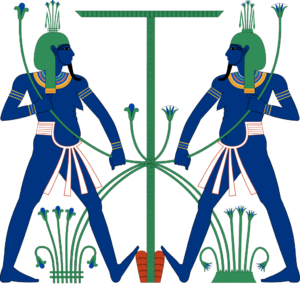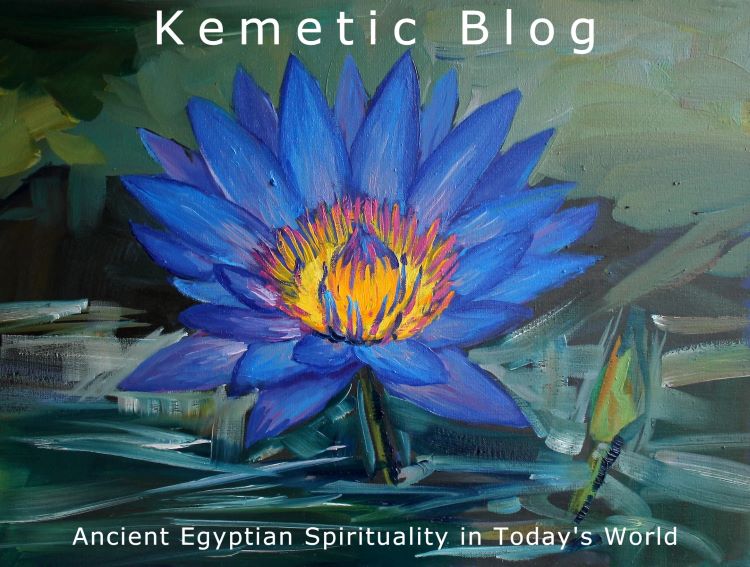
Dual depiction of Hapy, the ancient Egyptian god of the Nile and its flood, in the sema-tawy motif of unification of the two lands. He ties together the symbols of upper Egypt (the lotus, left half) and lower Egypt (the papyrus, right half), while the vegetation, large breasts and belly symbolize fertility and the blue skin symbolizes the Nile’s life-giving water. Image by Jeff Dahl via Wikipedia.
During Wep Ronpet this year, my part of the world is in the grip of another La Niña rain event. Surrounded by the element of water, I’m choosing to honour the circumstances in which I find myself and relating these events to the attributes of Hapi, god of the Nile river and of the inundation (Akhet), which used to occur in ancient times. It’s very much a time of putting up with the rain for the rainbow, so to speak. And if you appreciate these gifts, it’s a time of abundance and plenty. These are the themes I’ve been reflecting on during Wep Ronpet, and realising what an incredibly wet event this holiday would have been for the ancient Egyptians, and how welcome an abundance of water must have been in an otherwise arid region.
Within the Kemetic community, we tend to become preoccupied with the question of when is Wep Ronpet? We can easily overlook the meaning and significance of the holiday to both ancient and modern people alike. In my post on Wep Ronpet last year I did my best to provide a comprehensive overview as to when Wep Ronpet will occur and how to calculate it in your local area. I also shared a bit of my own Subjective Mystical Experiences (SMEs) with messages from the netjeru, who take great joy in people today expressing an interest in ancient Egyptian New Year. I also acknowledged the celestial influence of the goddess, Sopdet.
This year, to satisfy the majority of enquiries received at Kemetic Bog, I’ll recap when Wep Ronpet will occur for the next few years, including how you can calculate the date yourself by using the heliacal rising of Sirius / Sopdet as your reference, along with the inherent flaws and limitations of using this approach. Then I think it’s important to get past the when to celebrate Wep Ronpet and start looking at suggestions as to how we can celebrate it. I’ll be using an intuitive approach as to the how this year. Perhaps next year, I’ll look more closely at sources which examine the historical record to reconstruct a more ‘authentic’ Wep Ronpet. This year, I feel a need to focus on what’s happening in the world here and now, simply because there’s a lot happening. The need to focus on safe, peaceful and sensible solutions to problems and disagreements is a big issue right now both politically and personally — is it not?
The when of Wep Ronpet
One method of determining when Wep Ronpet will occur involves calculating the heliacal rising of the Dog Star, Sirius or Sopdet. This means when the star, Sirius rises for the first time each year in your local area or in Cairo, Egypt as you like. To do this, visit In-the-sky.org and type in your desired location. Then under Object Type, choose any and the Object put Sirius. There’s a column on the right (you’ll need to scroll a bit, if you’re using your phone) titled Observable (hover mouse). The first day after it stops saying “Not observable” is Wep Ronpet. I first discovered this method on Reddit and full credit goes to wolfboy180.
To simplify, if you wanted to celebrate Wep Ronpet with Cairo, here are the dates and years below:
2022: Aug 8
2023: Aug 8
2024: Aug 7
2025: Aug 8
2026: Aug 8
As mentioned previously, there are some flaws with using this approach, which essentially is that it doesn’t quite add up, anymore. The occurrence of Wep Ronpet in ancient times was like a recipe consisting of celestial, earthly and human ingredients. First, you needed a pharaoh. Then, when the heliacal rising of Sirius occurred at the location of the pharaoh, along with the annual inundation of the Nile, you finally had Wep Ronpet. Today, we no longer have a pharaoh, unless you follow Kemetic Orthodoxy and its leader, Tamara Siuda who is located in North America. The next problem, is the heliacal rising of Sirius no longer takes place at the same time in which it used to, meaning the rising of Sopdet no longer coincides with the inundation. Lastly, the Nile river itself no longer floods, due to the construction of the Aswan Dam. Now, I’m not trying to be a Negative Nancy, this is simply the reality in which we are working with. Today, most people are comfortable with the heliacal rising of Sirius in Cairo as marking the official day of Wep Ronpet, which takes place in August though in ancient times, Wep Ronpet occurred a little earlier, in July.
Take for example, author Sharon LaBorde who leads her own Kemetic Independent movement (mentioned many times previously in this blog), who observes Wep Ronpet on July 18 as this date is more in alignment with the time when the heliacal rising of Sirius and the inundation of the Nile coincided in ancient times (see Sharon’s article, The Ancient Egyptian New Year). In light of these considerations, I now look at Wep Ronpet as a Kemetic holiday season of sorts, taking place from late July to early August. I would say, let’s Kemeticise the concept of Christmas in July and move on, because there’s so much more to Wep Ronpet than grappling with when it occurs!
The how of Wep Ronpet
There’s no right or wrong way to observe Wep Ronpet. Honour the gods, ideals and culture of ancient Egypt according to what feels right for you. That might entail following a text book, watching a Kemetic service on YouTube or winging it with Isis like I do. In other words, your observance of Wep Ronpet is a personal experience and as such, I would suggest personalising it. Light a candle, burn some incense, offer food and drink, speak a few words and meditate; the netjeru are already there! That’s all I’ve been doing as a Kemetic practitioner, other than facilitating this blog, and it sustains a potent relationship with the deities, full of powerful subjective mystical experiences. I’m convinced a simple approach such as this will work for you, too.
Wep Ronpet has taught me to have a greater appreciation for water, and the raw power of nature. I recently moved back in with my old friend and housemate, in order for my partner and I to have a more pet-friendly place to live with our new puppy. There’s a creek which borders the property, and it has a fantastic energy. I’ve nicknamed this creek, the Little Nile. Of course, its size and energy is nothing like the real Nile river, but after living in a downtown apartment for over a year, I’ve realised the energy of this creek significantly contributes to my energy field, and more readily allows the ancient Egyptian deities to maintain a connection with me and anchor themselves within my living space. If not for this creek, I may never have established a connection with the netjeru in the first place. If a little creek can do all that, imagine the spiritual power of the Nile, and what it did for the spiritual growth of the ancient Egyptians. The creek is not a mere current of water running, but a current of living energy as well.
Your location definitely influences the level of available spiritual energy, which in turn, affects your spiritual growth. While it’s still possible to remain spiritually conscious in congested, urban spaces (I grew a lot of houseplants while living downtown) it’s more challenging to do so. Spending time near rivers, creeks and moving water is another way to observe Wep Ronpet, which is what I’ll be doing this year.
Thank you for reading Kemetic Blog, a Hapi Wep Ronpet to you!
Special thanks to Jason M. for helping me out with some technical WordPress issues, in which I effectively locked myself out of the blog, after installing a couple apps that may not have been compatible with the latest version of WordPress — I can’t thank you enough!
𓆸
© Scott Rose / Kemetic Blog – All Rights Reserved.

1 Comment
Making a Kemetic New Year's Resolution
August 22, 2022 at 1:01 am[…] Wep Ronpet this year, I decided to make my first Kemetic New Year’s […]